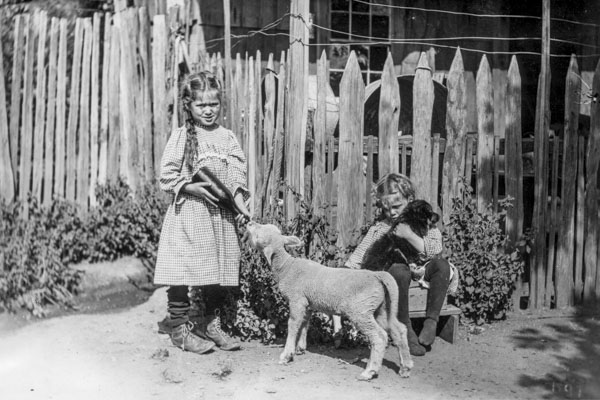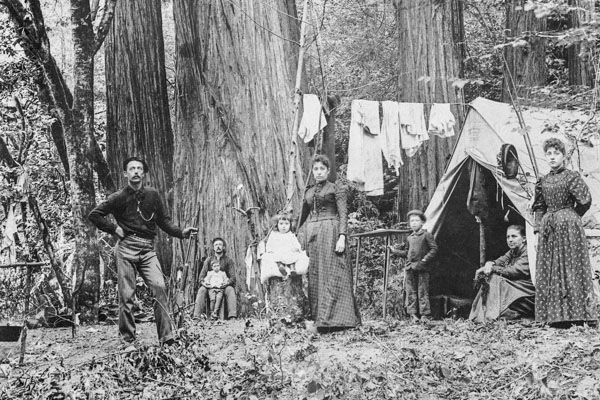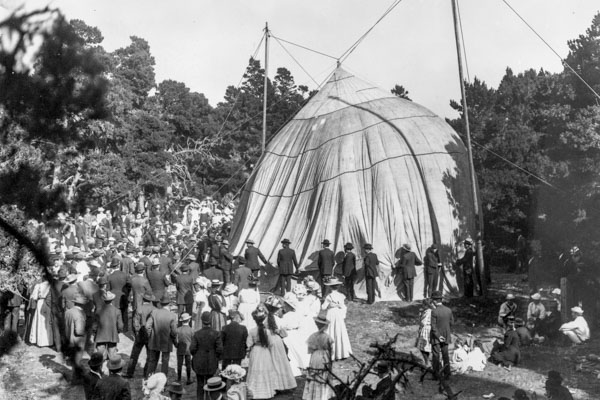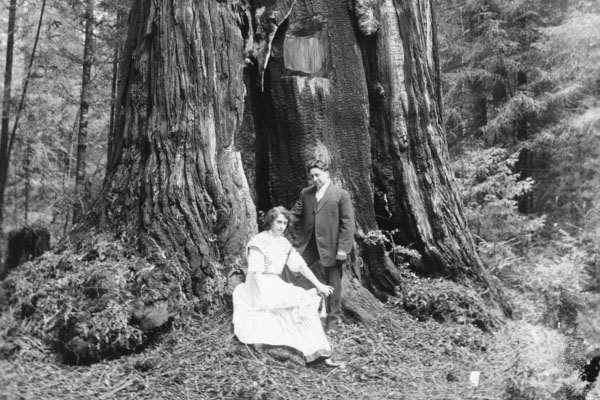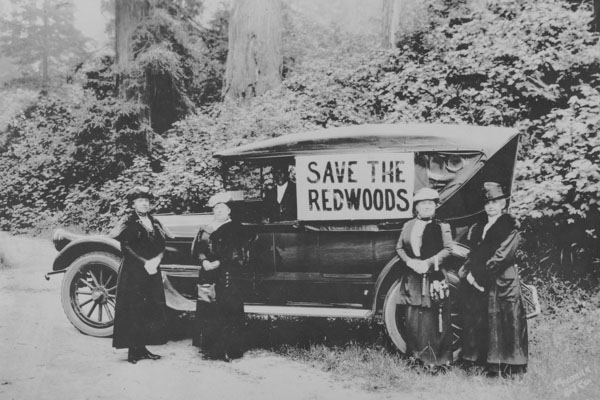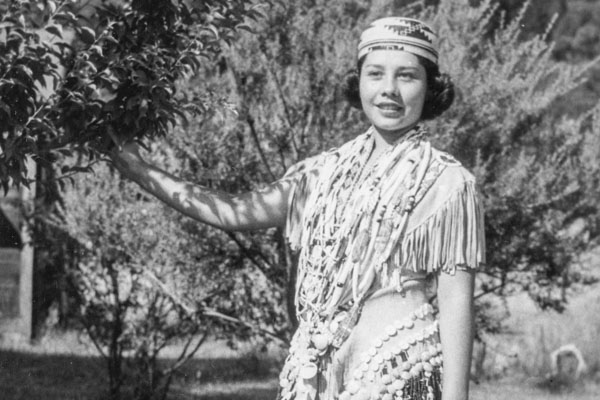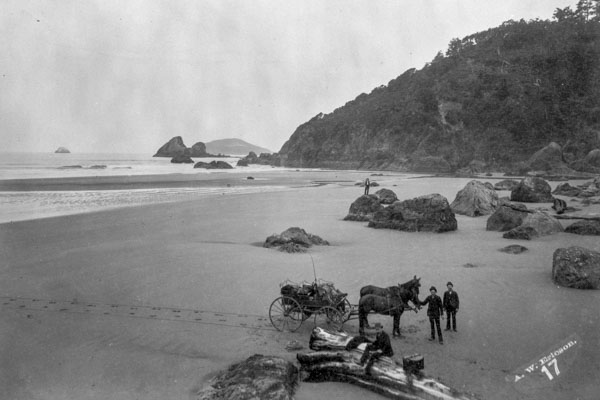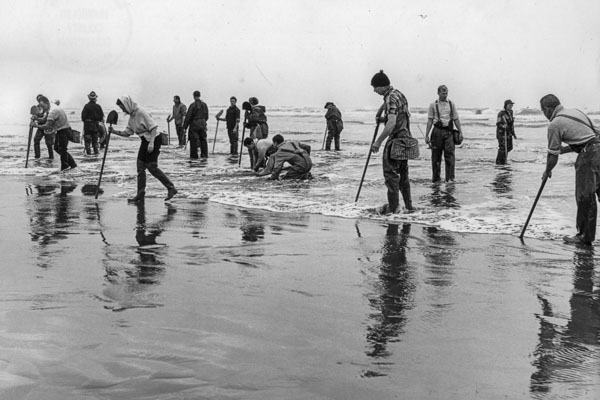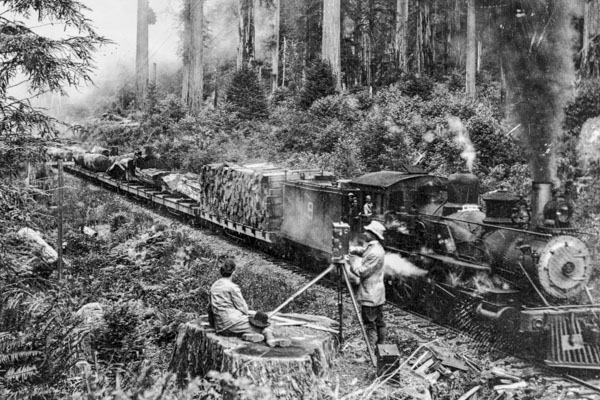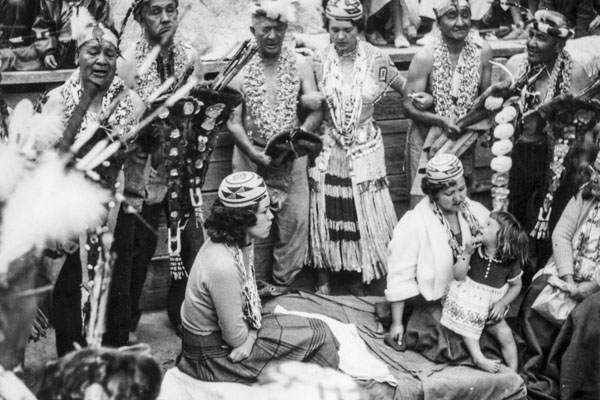You are here
Swanlund-Baker Photograph Collection - Biography
Ray Jerome Baker (1880-1972) worked as a self-employed photographer in Humboldt County from 1904 until sometime in 1910. In that year Baker and his family, wife, Edith Frost Baker, and son, Earl Frost Baker, made Hawaii their permanent home. Baker continued as a professional photographer and became renowned for his documentary and promotional images of Hawaii. He retired from active photography and public speaking in 1959. His life story is told in two books: Odyssey of a Cameraman and Hawaiian Yesterdays: Historical Photographs.
From Baker's manuscript memoir, Odyssey of a Cameraman, and from a 1959 letter he wrote to Dorothy Fletcher of Miranda we have Baker's own recollections about his time in Humboldt County. Included below are an excerpt from his memoir and the text of the letter. While the letter is a bit lengthy it is useful for its information about Baker's activities while in northern California and his comments on his career just at the time that he was giving up active work.
Odyssey of a Cameraman, p.9.
...I soon found an opportunity for outside photographic work. Men working in the logging operations liked pictures of themselves at their day-to-day work. Groups of them posed before their donkey engines, beside the skid roads, or as choppers beside a big redwood tree they were about to fall. I employed a girl to look after the studio during my absence and soon found myself busily engaged in the outside work. Later I purchased a motor cycle which aided materially in getting about the country. On it I made forays into the far reaches of Humboldt County, sometimes even outside. My interest in outside work did not, however, preclude portrait and studio work inside. I became friendly with the local theater man, a relationship which resulted in considerable numbers of theater people coming to my studio for pictures. They expected low prices, but were always wanting more pictures. Stock companies sent their leading ladies and various members to be photographed. It should be point out that motion pictures had not yet assumed a leading role in public entertainment. Marguerita Fisher was a very charming young woman who headed her own company. She was still quite young and apparently unmarried, for her mother traveled and looked after her. Auda Due, obviously an assumed name, played opposite her husband, Pietro Sosso, a fine man and a fine actor of Italian ancestry....
Letter from Ray Jerome Baker to Mrs. Dorothy Fleckner
R.J. Baker, Photographer,
Publisher of Fine Books
1911 Kalakaua Avenue,
Honolulu, 15 Hawaii.
March 3, 1959
Mrs Dorothy Fleckner,
Forest of Arden,
Miranda, California.
Thank you for your letter of February 17 which reached me last week. I agree with you that something ought to be done about the Log House but the matter is entirely out of my hands. I put a lot of loving care and effort into building the place (and hard earned money too) but the land was always in Mrs Baker's name, after the death of her mother about 1913, and after her own death she willed it to my son, Earl Frost Baker. So he is the complete owner of the property now. There is not much I can do about it, except perhaps turn your letter over to him for any action or attention he chooses to give to it.
I am enclosing a few old pictures in this letter which may be of interest to you. Back in the early 1900's I had a motorcycle and used to go into the back country making pictures I used to visit Briceland, Garberville and Shelter Cove. On occasion such as July 4th they would have celebrations and the Indian people would come out. It was on such an occasion that I made these of some of the Indian people who turned out. They were sturdy folks with simple lives and primitive living conditions, and I believe, on the whole, well behaved. I was told that the hard looking woman sitting in the cart (also a close-up of her) was pretty hard-boiled and earlier in life had "killed a man." This was a rather vague statement, and I do not know whether or not it was true.
Shelter Cove in those days was a shipping point for tan oak bark. The wagon teams brought the bark in from the various valleys and gulches where it had been peeled, and dried. Peeling tan bark had to take place in the spring time when the tan-oak trees were full of sap. In the village of Briceland was a plant for processing the bark. The Wagner Leather Company, which had its main plant and tannery in Stockton took bark at its Briceland plant. Here it was ground up and put through a soaking or leeching process and the liquor or tannin solution was evaporated in a vacuum boiler to the consistance [sic] of a heavy syrup. Then it was put in heavy barrels and the concentrated tannin solution was shipped to the tannery in Stockton, by way of boats from Shelter Cove. Briceland was a busy place, especially in summer.
Mr Frost, my father-in-law, had great faith in the Briceland region as having possibilities for oil wells. For many years natural gas was burned in several of the places in the town of Briceland. I have had no information in recent years, but gas may, insofar as I know, still be piped into some of the places in the village. In Shelter Cove the boats that came in carried both the dried tan bark and the tan bark extract which was in barrels. For a time there was a light oil rig on a farm near the village, in which Mr Frost was interested. I think their drilling rig was too light and too poorly financed to accomplish much, and nothing came of it.
Quite early in Humboldt history and well beyond my own time, Mr Frost and his brother-in-law, one of the Dale brothers, (Mrs Frost was a Dale) were in partnership in a sheep ranch. It was in the hills and not too far from Briceland. I suspect the wild cats and the bears too liked young lamb pretty well and I am not sure that they made a very great success of their sheep ranch venture. Anyway they gave it up, and I am sure that doing politics and selling life insurance was found by Mr Frost to have been a more profitable occupation.
I recall very well being in Briceland on one Fourth of July. I shared my hotel room with a young lawyer who had been booked to make the patriotic speech of the day. We had arrived two or three days before the big event came off, and in the seclusion of our room he demonstrated for me his abilities as a speech maker. There was much drunkiness [sic] in the town and our erstwhile speech maker felt the necessity of a little stimulent [sic] and in fact had too much, so I cannot say that his July 4th speech was an unqualified success. There was quite a considerable group of Indians from the surrounding country and most of the villagers turned out. As a further part of the program there was the reading of the Declaration of Independence. In fact I think this reading preceeded [sic] the speech making. If you have not read the Declaration in recent years, you should do so, for I am sure you will agree that the public reading of the document could qualify one as being subversive and a dangerous communist, by present day jittery standards.
One thing about the old timers was that they did their best to be self-sufficient. They had to do so. They raised poultry, made garden, raised their own potatoes, kept milk cows, kept pigs - the last allowed to run wild and especially to get fat on the acorns in the fall. Bacon fattened on acorns was supposed to be tops. There was no power equipment - only hand tools, the scythe, the hoe, the axe, the draw-knife and the tool for making shakes. A team of horses furnished the power. Old timers have told me of the days when the county road ended in Dyerville and the rest of the way up the valley had to be done with a four horse team over the river-bar. It was a painful process to get the needed supplies in from the outside. The old timers always had their shooting irons and killed deer when they needed meat. Some of them raised a little grain, feed for their horses, and some had their thrashing floor where horses were driven round and round to tramp the grain out.
My primary objective in writing this time was to acknowledge recipt [sic] of your letter. Since I first visited Honolulu in 1908, I had planned to give up photographic work in California, and have never regreted [sic] my change. I have been around the world; visited over fifty countries; been to Europe three times; to Australia, New Zealand, most of the countries of South America, Alaska, Tahiti, Samoa, Fiji, Egypt, the Holy Land. I do not know when I will be in Humboldt - Miranda to be explicit - again, but I will indeed be happy to meet you and your husband, Mr Flecker.
Sincerely,
[signed]
Ray Jerome Baker
